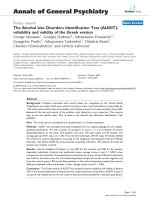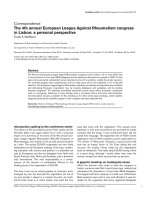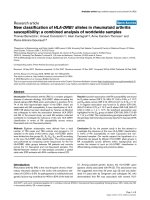Báo cáo y học: "he International Sepsis Forum’s controversies in sepsis: corticosteroids should be used to treat septic shock" doc
Bạn đang xem bản rút gọn của tài liệu. Xem và tải ngay bản đầy đủ của tài liệu tại đây (33.54 KB, 3 trang )
ACTH = adrenocorticotrophic hormone.
Available online />In the early 1980s we were big proponents of using
corticosteroids in septic shock, whereas in the late 1980s,
following publication of the findings of the Veterans
Administration Systemic Sepsis Cooperative Study Group on
corticosteroids in sepsis [1] and those of the study of steroids
in sepsis conducted by Bone and colleagues [2], we thought
corticosteroids were a bad idea. In fact, subsequently, two
meta-analyses [3,4] concluded that steroids were not
beneficial in sepsis and septic shock. Based on recent data,
there is enough evidence to suggest that we probably should
be using corticosteroids in our septic shock patients.
Although we support the use of steroids for treating septic
shock, we clearly need a large trial in this area. In fact, we are
starting a prospective, randomized, double-blind trial in
Europe that will enroll large numbers of patients with septic
shock (the CORTICUS study).
In 1984, our group showed [5] that there was a short period
of time with a difference in mortality between a steroid-
treated group and a control group, and that there was a
significant reversal in shock between the groups at 24 hours.
We stated at that time that perhaps we should be giving
steroids for a longer period of time rather than just two
doses. This approach was likely to reverse shock in more
patients and perhaps improve survival.
There has clearly been a change in thinking of how steroids
should be used, in treating both septic shock and the acute
respiratory distress syndrome. Older studies used large
doses for short periods of time, and were given early in the
treatment – typically one or two doses of
methylprednisolone (30 mg/kg). This was often done before
any organisms were identified, and hence using
corticosteroids might be associated with an increased
incidence of complications related to superinfections.
However, more recent studies recommend smaller doses of
steroids, used for longer periods and given even later in the
course of the disease.
Commentary
The International Sepsis Forum’s controversies in sepsis:
corticosteroids should be used to treat septic shock
Sergey Goodman
1
and Charles L Sprung
2
1
Senior physician, Department of Anesthesiology and Critical Care Medicine, Hadassah Hebrew University Medical Center,
The Hebrew University of Jerusalem, Israel
2
Director, General Intensive Care Unit, Department of Anesthesiology and Critical Care Medicine, Hadassah Hebrew University Medical Center,
The Hebrew University of Jerusalem, Israel
Correspondence: Charles L Sprung,
Published online: 17 July 2002 Critical Care 2002, 6:381-383
This article is online at />© 2002 BioMed Central Ltd (Print ISSN 1364-8535; Online ISSN 1466-609X)
This article is based on a Pro-Con debate at the 31st Annual Congress of the Society of Critical Care Medicine (SCCM), San Diego, California, USA,
26–30 January 2002, and may not necessarily reflect the actual opinion of the author. The presentation was supported by the International Sepsis
Forum (ISF).
Abstract
The use of corticosteroids in septic shock remains controversial. It has been demonstrated that high
doses of steroids (30 mg/kg methylprednisolone) for short periods of time are not beneficial. More
recent studies using smaller doses (200–300 mg/day hydrocortisone) for longer periods of time have
shown beneficial effects. These positive effects have included reversal of shock, trends toward
decreased organ system dysfunction and decreased mortality. Based on the high proportion of
patients who have relative adrenal insufficiency, the benefits of low doses of steroids and the minimal
risks, steroids should be used to treat septic shock.
Keywords corticosteroids, relative adrenal insufficiency, septic shock, survival
Critical Care October 2002 Vol 6 No 5 Goodman and Sprung
Relative adrenal insufficiency
During septic shock there is an important problem of relative
adrenal insufficiency. This causes adrenergic receptor
desensitization – a decreased number of both α- and
β-adrenergic receptors. This is either related to sepsis itself
or to the use of vasopressors for long periods of time.
Corticosteroids may help with the resensitization of these
receptors, leading to haemodynamic improvement –
decreasing catecholamine requirements, reversal of shock
and perhaps even reversal of organ system failure. All of
these effects may decrease mortality.
Annane and colleagues [6] found the highest 28-day
mortality (82%) in patients who had high baseline cortisol
levels and who did not respond to adrenocorticotrophic
hormone (ACTH) by increasing cortisol levels by greater than
9 µg/dl. If one looks at relative adrenal insufficiency in terms
of nonresponders to ACTH (≤ 9 µg/dl), then the mortality in
that group was 72%, whereas in those who did respond to
ACTH the mortality was 32% – more than double. How
common is relative adrenal insufficiency? In the study
conducted by Annane and colleagues [6] it was 54%, but in
some recent data there are suggestions that between two-
thirds and three-quarters of patients with septic shock may
have relative adrenal insufficiency. Therefore corticosteroids
would be helpful in many patients.
Clinical data looking at the increase in mean arterial pressure
after noradrenaline (norepinephrine) administration [7] show
that there is a greater response to noradrenaline in patients
with normal adrenal function than in those with impaired
adrenal function. However, when one gives low doses of
corticosteroids to patients with impaired adrenal function the
responses to noradrenaline move closer together, so that
there are no longer statistical differences in the noradrenaline
effects of increasing blood pressure [7].
Shock reversal
The prospective, randomized, double blind study conducted
by Bollaert and colleagues [8] looked at 41 patients who
required catecholamines for more than 48 hours and had
been in shock for 5–6 days. By that time the patient’s
infectious organisms had most likely been identified and they
were probably on appropriate antibiotics, so there were few
problems in terms of complications of corticosteroids.
Patients were given 100 mg hydrocortisone intravenously
three times a day for 5 days. Treatment was discontinued if
shock did not reverse. If shock reversed, then treatment was
continued with half doses for 3 days and quarter doses for
another 3 days and stopped. There was significant shock
reversal at 7 days, and 28-day mortality showed a trend
toward significance (63% versus 32%).
Briegel and colleagues [9] performed a prospective,
randomized, double-blind, single-centre study in
hyperdynamic septic shock patients. They enrolled septic
patients who were on vasopressors and had been in shock
for at least 3 days. While on vasopressors, patients were
given a bolus of 100 mg hydrocortisone or placebo, followed
by a continuous infusion of 0.18 mg/kg per hour of
hydrocortisone or placebo. In addition to a decreased mean
time for shock reversal, there also seemed to be a trend
toward decreased organ system dysfunction in the steroid-
treated group as compared with the control group.
A multicentre, prospective, randomized, double-blind French
study [10] involved 300 patients enrolled early after the onset
of shock. Among nonresponders (≤ 9 µg/dl increase in
baseline cortisol after ACTH), there was greater survival in
the steroid-treated group as compared with the placebo
group. Interestingly, there was a trend toward a higher
mortality in those patients who were responders and treated
with steroids. Therefore, it is important to evaluate
corticosteroids in a larger group of patients, evaluating both
responders and nonresponders.
In addition to efficacy, which is discussed above, safety is also
important. The problems associated with corticosteroids
occurred in those studies that used high doses (1–2 g
methylprednisolone). When lower doses (200–300 mg/day of
hydrocortisone) were used, superinfection and other
complications were not observed. The one study that did have
a complication was the study conducted by Briegel and
colleagues [9]. Patients developed hyponatraemia and
increased alanine aminotransferase levels at day 14. The
hyponatraemia was probably related to the continuous infusion.
Conclusion
What should one do at the present time? For routine use of
low doses of corticosteroids in septic shock, there are
minimal or no risks. There are data to suggest that relative
adrenal insufficiency is a common problem in the majority of
patients with septic shock. Therefore, physicians can reverse
shock and improve survival with corticosteroids, as was
shown in the prospective, double-blind study reported by
Annane and colleagues [10]. One should be aware that, in
the study by Annane and colleagues, patients were in septic
shock with systolic blood pressure below 90 mmHg for more
than 1 hour. This is not the usual patient because most
respond to fluids and vasopressors within an hour.
In summary, in the typical septic shock patient, based on the
data we already have, given the frequency of relative adrenal
insufficiency in this population and the lack of a downside to
the use of lower doses of corticosteroids, the routine use of
corticosteroids is probably beneficial. If physicians do not
want to use them early, then they should wait a few days so
as not to worry about superinfection.
Competing interests
PST received an honorarium from the International Sepsis
Forum for helping to write this commentary.
Acknowledgements
We thank Pritpal S Tamber for his assistance in helping us write this
commentary. We also thank the International Sepsis Forum (ISF) and
the Society of Critical Care Medicine (SCCM) for inviting Charles
Sprung to participate in this debate during the SCCMs annual con-
gress in San Diego, USA, in January 2002. For more information about
ISF, see .
References
1. The Veterans Administration Systemic Sepsis Cooperative Study
Group: Effect of high-dose glucocorticosteroid therapy on
mortality in patients with clinical signs of systemic sepsis. N
Engl J Med 1987, 317:659-665.
2. Bone RC, Fisher CJ Jr, Clemmer TP, Slotman GJ, Metz CA, Balk
RA: A controlled clinical trial of high-dose methylprednisolone
in the treatment of severe sepsis and septic shock. N Engl J
Med 1987, 317:653-658.
3. Lefering R, Neugebauer EAM: Steroids controversy in sepsis
and septic shock: a meta-analysis. Crit Care Med 1995, 23:
1294-1303.
4. Cronin L, Cook DJ, Carlet J, Heyland DK, King D, Lansang MA,
Fisher CJ Jr: Corticosteroid treatment for sepsis: a critical
appraisal and meta-analysis of the literature. Crit Care Med
1995, 23:1430-1439.
5. Sprung CL, Caralis PV, Marcial EH, Pierce M, Gelbard MA, Long
WM, Duncan RC, Tendler MD, Karpf M: The effect of high-dose
corticosteroids in patients with septic shock: a prospective,
controlled study. N Engl J Med 1984, 311:1137-1143.
6. Annane D, Sebille V, Troche G, Raphael JC, Gajdos P, Bellissant
E: A 3-level prognostic classification in septic shock based on
cortisol levels and cortisol response to corticotropin. JAMA
2000, 283:1038-1045.
7. Annane D, Bellissant E, Sebille V, Lesieur O, Mathieu B, Raphael
JC, Gajdos P: Impaired pressor sensitivity to noradrenaline in
septic shock patients with and without impaired adrenal func-
tion reserve. Br J Clin Pharmacol 1998, 46:589-597.
8. Bollaert PE, Charpentier C, Levy B, Debouverie M, Audibert G,
Larcan A: Reversal of late septic shock with supraphysiologic
doses of hydrocortisone. Crit Care Med 1998, 26:645-650.
9. Briegel J, Forst H, Haller M, Schelling G, Kilger E, Kuprat G,
Hemmer B, Hummel T, Lenhart A, Heyduck M, Stoll C, Peter K:
Stress doses of hyperdynamic septic shock: a prospective,
randomized, double-blind, single center study. Crit Care Med
1999, 27:723-732.
10. Annane D: Effects of combination of hydrocortisone
(HC)–fludro-cortisone (FC) on mortality in septic shock
[abstract]. Crit Care Med 2000, 28:A46.
Available online />









